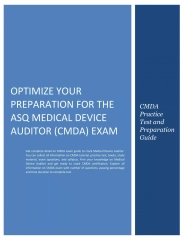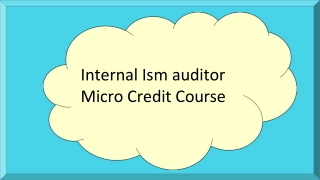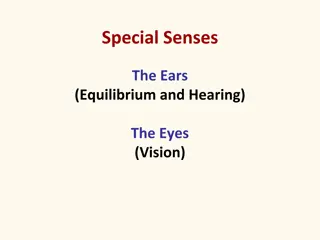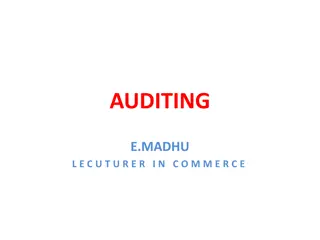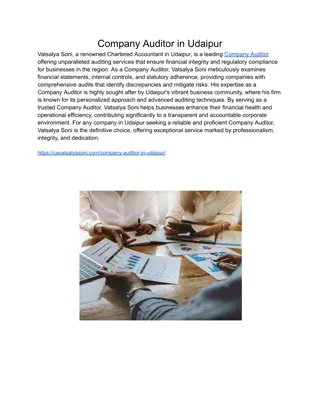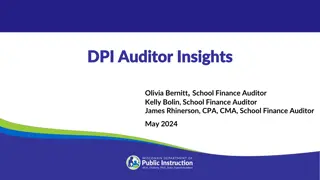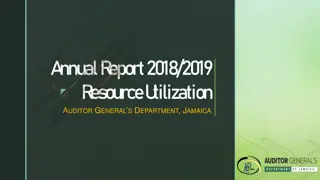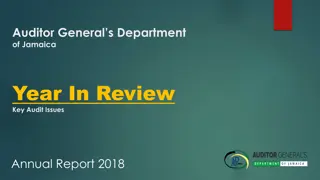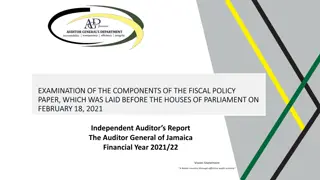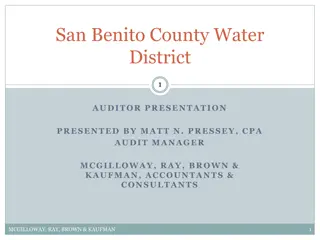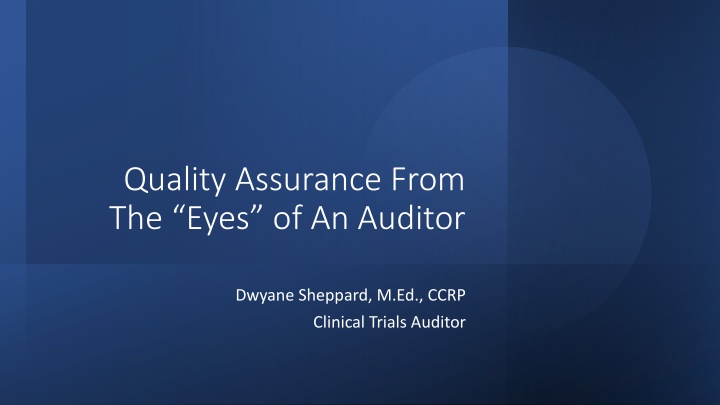
Insights into Quality Assurance Auditing
Delve into the world of quality assurance through the eyes of an experienced auditor, Dwyane Sheppard. Explore best practices, internal quality assurance methods, and the importance of consistency, communication, collaboration, and correctness in maintaining quality standards. Learn how to implement continuous improvement programs and SOPs to ensure compliance with regulations and guidelines.
Download Presentation

Please find below an Image/Link to download the presentation.
The content on the website is provided AS IS for your information and personal use only. It may not be sold, licensed, or shared on other websites without obtaining consent from the author. If you encounter any issues during the download, it is possible that the publisher has removed the file from their server.
You are allowed to download the files provided on this website for personal or commercial use, subject to the condition that they are used lawfully. All files are the property of their respective owners.
The content on the website is provided AS IS for your information and personal use only. It may not be sold, licensed, or shared on other websites without obtaining consent from the author.
E N D
Presentation Transcript
Quality Assurance From The Eyes of An Auditor Dwyane Sheppard, M.Ed., CCRP Clinical Trials Auditor
Objectives 1. To Discuss and Identify Best Practices Learned From Conducting Audits 2. To Help Improve Study Conduct From Lessons Learned By Implementing Internal Quality Assurance Practices
Quality assurance can be defined as "part of quality management focused on providing confidence that quality requirements will be fulfilled." Definition of Quality Assurance
To implement a continuous quality improvement program/process that utilizes accuracy, consistency, collaboration, and communication to improve, create, develop and maintain a workplace culture of compliance My Objective As An Auditor *** Should be in line with your departmental, institutional, federal, and state regulations and guidelines
Consistency Communication Components of Quality Assurance Collaboration Correctness
Have a standardized process of what you do and how you do it. Develop Standard Operating Procedures (SOP s) Consistency: Develop a consistent training/education program Enable study team to share a common and uniformed view of the ultimate goal. Internal/External customers will know what to expect each time (creates trust)
Consistency (con t): How to Maintain 1. DEFINE YOUR QUALITY EXPECTATIONS FOR THE PROJECT 2. COMMIT TO THOSE QUALITY EXPECTATIONS 3. MANAGE FOR QUALITY 4. CONTROL THE QUALITY 5. DOCUMENT LESSONS LEARNED
How well you utilize effective means of interaction with your customers. Ensure all involved understand the goals in mind Provide feedback (constructive) Communication Cross training of roles, responsibilities of study related tasks Be transparent Develop a point of contact to disseminate milestones, setbacks, etc
How well you work with internal/external customers Helps to have 1-2 points of contact Invite some of those collaborators to team meetings/trainings Collaboration Respond to inquiries in a timely manner Be professional ; titles do not make us professional, our mindset does Enhance team members engagement (gives team member autonomy) Improve quality indicators across the board
Collaboration (cont) Cultivates openness and transparency Creates a place where ideas can be shared Improves relationships across departments.
Correctness (accuracy): results conform to the standard How well you record what you have done How well you report what you have/have not done Overtime improves attention to detail Lends to more validity and reliability of the data collected How well you monitor what you have done Overtime improves cohesiveness of the team
1. Team members must take ownership of their role in the research project 2. Measure the team member s ability or desire to make decisions (out of the box thinking not defined by an SOP/policy) Empowerment In Relation To Quality 3. Team member recommends what works (solution oriented): I.D.E.A.S. I-Ingenuity D- Decisiveness E-Engagement A- Alignment with goal/goals S- Share with others 4. Allows the ability to accept feedback without internalizing as negative or fear of being punitive. 5. Improves morale (your stake in the success of the project)
Behavioral Factors Related To Empowerment (Quality Improvement) Sometimes we are so focused on systems regarding process improvement (quality), that the human factor is not accounted for. We move to change or do away with a system(s) we created with haste, that we generally do not account for the individuals implementing the system (s) created
Behavioral Factors (cont): Intangibles TRUST- BE ABLE TO SEE AND EXPECT OF YOURSELF WHAT YOU SEE AND EXPECT OF OTHERS MOTIVATION; BE INTENTIONAL ABOUT YOUR COMMITMENT AND WHY- BE DELIBERATE MAKE A SELF- ASSESSMENT ABOUT YOUR ABILITIES- HOW WELL WERE TRAINED WEATHER-MAN MINDSET- ABILITY TO FORECAST ANTICIPATE ISSUES, DESIRED OUTCOMES SCENARIO-BASED LEARNING AND IMPLEMENTATION VALUES- INTRINSIC NEED TO IMPROVE, SELF AWARENESS, BELIEF SYSTEM **WE SHOULD TRAIN OUR MINDS TO ANTICIPATE PROBLEMS/ISSUES TWO-WAY MIRROR
Standardization In Quality Talk the same language when communicating outside your department about department processes Be clear/concise/comprehensive This decreases errors and improves efficiency Form of protection: for Institution, Staff, and partners Creates a solid foundation to build upon
Value Of SOPs Should be a reflection of tasks relevant to your department/institution Serves as points of reference on how to perform those tasks Always subject to changes/modifications/ amendments If you say you are doing something indicated in an SOP you have to prove it and there is an obligation to follow the SOP. SOP s says what you will do not what you won t do?
CAPA: Purpose is to collect information, analyze the information, identify and investigate the problem, and take appropriate and effective corrective and/or preventive action to prevent recurrence Collect Value of CAPAs: Corrective and Preventive Actions Corrective Action: Focus on implementing changes to an identified existing breach in a process or system Focus on Preventive Action: Focus on eliminating the cause for any potential breaches in a processor system Focus on
Benefits Of An Internal QA Program PREPARES FOR AUDITS (FDA, CRO, SPONSORS ETC) ALLOWS YOU TO IDENTIFY AN ISSUE BEFORE IT BECOMES AN ISSUE BRIDGES GAPS ACROSS DEPARTMENTS OPPORTUNITIES FOR IMPROVEMENT CREATE METRICS TO ENHANCE LEARNING/EDUCATION CREATE AN ENVIRONMENT FOR OUT OF THE BOX THINKING INCREASE THE LIKELIHOOD DATA COLLECTED IS AS CLEAN, RELIABLE, AND VALID AS EXPECTED.
Things Ive Seen: Consenting: authorized consenter, one signature vs two signatures, correct LAR, etc Incongruent database (EMR vs EDC) Adverse event reporting Be more proactive vs reactive: helps to create contingencies Regulatory (DOR, 1572, GCP/HSP, training) Documentation (explaining gaps)
Additional Support To QA Program DATA SAFETY MONITORING BOARDS CLINICAL RESEARCH MONITORING SCIENTIFIC REVIEW COMMITTEES INTERNAL MONITORING COMMITTEES INSTITUTIONAL REVIEW BOARDS
QA Program: Things To Consider Use information learned from your internal QA program and develop metrics to use as training tool Minimize the use of Note To Files: Consider CAPAS Look at how to bridge gaps in communication between groups QA is not punitive: a tool for process improvement Gives opportunity to have a fresh set of eyes to look at things Makes you more proactive about a culture of quality Focus on what your expectations are from the onset
Comprehensive Quality Assurance Becomes Intentional Quality Compliance & Intentional QC Becomes Comprehensive QA * Proper Preparation Prevents Poor Performance *Consistency, Communication, Collaboration


